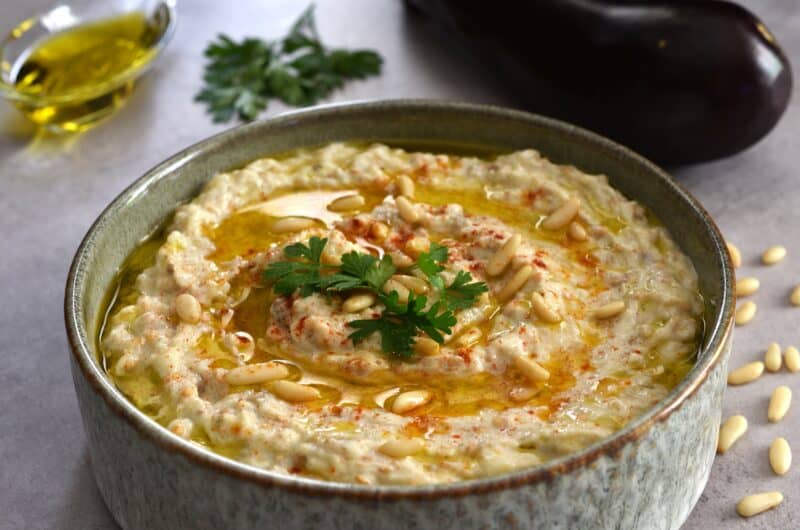Baba ganoush, or moutabal as it’s called in some countries, is a delicious Middle Eastern dip made from roasted eggplants, tahini, garlic, lemon juice, and optional (vegan) yoghurt. We’ll be using soya yoghurt in this recipe. This immensely popular dish stands out for its smoky allure and rich, creamy texture. Baba Ganoush is often served as part of a meze platter or as an appetiser, along with pitta bread, kaak (Middle Eastern bread sticks), crackers, or vegetables. I love serving it at parties and gatherings as part of a buffet spread. It’s so popular – it’s always one of the first things to disappear!

About this recipe
To make this vegan baba ganoush (moutabal) recipe, you will need to roast the eggplants whole until they are soft and tender inside. You can do this in three ways (more about that below). Then, you remove the skin and mash the flesh with a fork. Next, add tahini, garlic, lemon juice, vegan yoghurt, salt, and olive oil to the mashed eggplant and mix well. You can adjust the seasoning according to your own personal taste. It’s so quick and easy to make – it takes just 10 minutes of hands-on time.

Baba ganoush is a healthy and nutritious dish that is rich in fibre, vitamins, and minerals. Aubergines (aka eggplants) are low in calories and high in antioxidants that help protect your body from harmful free radicals. Tahini is a good source of protein, healthy fats, and minerals such as iron and calcium.
Baba ganoush is a versatile dish that can be customised to suit your taste preferences. You can garnish it with parsley, green coriander leaf (cilantro) or sumac to give it a fresh flavour. Or you could add warm spices such as cumin, paprika or Aleppo chili pepper to enhance its naturally smoky flavour. Try making it at home today and impress your friends and family with your culinary skills!
The origins of baba ganoush – a journey through the Mediterranean
Before we embark on our baba ganoush adventure, let’s take a moment to appreciate the remarkable journey this dish has taken. Originating in the Levant region, Baba Ganoush (also spelt baba ghanoush or baba ghanouj) has earned a place of honour in Mediterranean and Middle Eastern cuisines. Its influence has since transcended borders and is now immensely popular all over the world.
How to roast the aubergines
You can do this in one of three ways, depending on what equipment you have and what’s easiest for you.
- In the oven – I use this method because I don’t have a barbecue or a fireplace. I simply turn the oven temperature up to maximum and leave the aubergine on the second shelf for about 40 minutes until it’s well charred, turning it once halfway through the cooking time, When you take it out of the oven, it will collapse – this means it’s perfectly cooked on the inside.
- On a barbecue/grill – If your barbecue is already hot, it makes sense to roast the aubergine on there. This method will make the aubergine flesh irresistibly smoky.
- On an open flame – This is also a great way of roasting an aubergine for baba ganoush. Obviously, if you have to stand holding it for half an hour, there’s not much point because that’s precious time that you could use for something else. But if you’ve got a fire going, you can roast an aubergine in the same way that you would roast potatoes. Remember, an open flame, though – no aluminium foil.

Some useful tips before you start
- The aubergines are roasted whole for baba ganoush (moutabal). The more charred they are, the smokier the flavour! Always remember to prick the skin with a fork to allow the steam to escape and put something like aluminium foil underneath the aubergine so that you don’t have a huge mess to clean up afterwards. Trapped steam causes the aubergine to explode!
- When you scoop out the flesh with a spoon, scrape the inside of the skins well, even if it looks a bit burnt – that’s where the smoky flavour comes from!
- Not all baba ganoush (moutabal) recipes call for yoghurt. I love it – it adds a fresh, rich, creamy flavour, which I think improves both the texture and taste. Try making half with yoghurt and half without, and then decide for yourself.
- Stir half of the oil into the mixture and drizzle the other half over the top.
- Spices and herbs should be used to enhance the natural flavour of this baba ganoush – not disguise or obscure it. Be selective in their combinations and avoid using too many at one time. The beauty of this dish lies in its simplicity.
How to make vegan baba ganoush (moutabal)

Ingredients
- Aubergine – The big, fat purple varieties (globe or Italian) are best for making baba ganoush because they have a lot of pulp. I use whatever kind I happen to have on hand. That could be the more slender purple ones, striped ones (called zebra, graffiti, fairytale, or Sicilian aubergines), or the lighter-coloured fat violet ones
- Garlic – mince the garlic very finely or reduce it to a paste using the flat side of a butter knife and a tiny pinch of salt.
- Tahini (also spelt tahina) –
- Salt – I use Guérande unrefined sea salt.
- Lemon juice – freshly squeezed lemon juice is best.
- Vegan yoghurt – I use Alnatura unsweetened soya yoghurt, which I buy here in Switzerland. Unsweetened soya milk is best because it has a more neutral flavour. Use your favourite kind of unsweetened plant-based yoghurt for this recipe.
- Extra virgin olive oil – If you can get your hands on organic cold-pressed extra virgin olive oil, it will make all the difference to this recipe.
- Pine nuts – For garnish. Sprinkle them over the top.
- Sumac, Aleppo chili pepper, or paprika – For garnish. I love sumac, but I’d run out of both sumac and Aleppo chili pepper, so I used paprika instead. Use mild, hot, or smoked paprika, whichever you prefer.
- Parsley or coriander leaf – For garnish. Chop it finely. I used parsley because I’ve got plenty of it growing in the garden. The slugs got the coriander as soon as it sprouted this spring. I tried three times and then gave up, so no coriander from the garden this year.
Instructions
In the recipe card below, you’ll find step-by-step instructions with photos.
- Preheat the oven to the highest temperature (at least 250 °C).
- Wash the aubergine, but don’t trim it. Prick the skin in several places with the prongs of a fork. This is to let the steam escape so that the aubergine doesn’t explode. When the oven is hot, place the whole aubergine, stalk included, on some baking paper or aluminium foil on a baking tray. Roast the aubergine on a baking tray on the 2nd shelf until the skin starts to char on top. Turn the aubergine and char again. Remove from the oven and allow to cool.
- Once the aubergine has cooled down enough to handle, cut it open and scoop out all the flesh with a spoon.
- Place the pulp in a strainer and allow it to drain for 10 minutes.
- Transfer the aubergine pulp to a bowl. First, chop it up and then mash it with a fork. Add the minced garlic, tahini, lemon juice and salt.
- Mix well. Stir in the soya yoghurt if using. Taste and correct the seasoning if necessary. Transfer your vegan baba ganoush (moutabal) to a serving bowl. Drizzle the oil all over the top and garnish to your liking (see suggestions above).
How to serve baba ganoush (moutabal)
Here are some great ways of serving your vegan baba ganoush!
- dish it up as a dip, with pitta bread and/or crudités (raw vegetable sticks)
- serve it as a meze dish, along with other hot and cold dishes like hummus, kofte, tabbouleh, olives, pitta, and a Mediterranean dip or two.
- make it part of a buffet spread, with things like focaccia, salads, vegan quiche, mini pasties, etc.
- spread it on bread and eat it as a snack

How to store baba ganoush (moutabal)
I really doubt you’ll have any baba ganoush left to store! But if you do, put it in an airtight container in the fridge, where it will keep for a day or two. If it was out on a buffet for more than a couple of hours, it’s probably best not to keep it for longer than another day in the fridge.
Can you freeze baba ganoush?
Yes, you can, but I don’t really recommend freezing it. It keeps well in the fridge for 2 or 3 days, so there’s not much point in freezing it. Plus, freezing it alters the flavour. At our house, it never lasts for more than 24 hours anyway because we can’t keep our hands off it!
If you liked this recipe for raspberry sorbet, it would be great if you could give it a star rating and leave a comment below! It helps other readers to find my content and posts and ultimately makes my blog more successful! Thanks so much for your support! Deborah xx
While you’re here on Vegan Hot Stuff, maybe you’d like to take a look at some other popular recipes…






Would you like to receive my recipes as soon as I publish them? Subscribe below!










I love eggplant myself…but this cream is so delicious to the point that if you close your eyes you feel all the flavors explode and leave you with a satisfied palate.
The recipe simple but impressive.
The guests devoured it all!!!
That’s great to hear Monica! Baba ganoush is delicious, I’m really glad everyone enjoyed it!